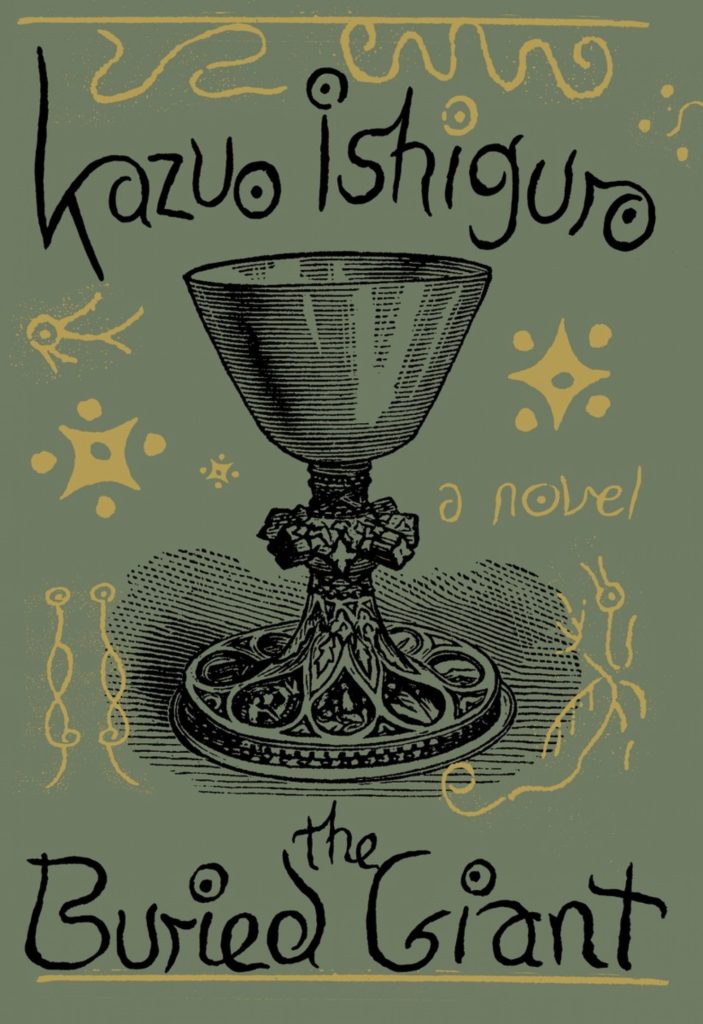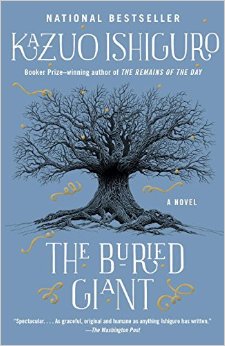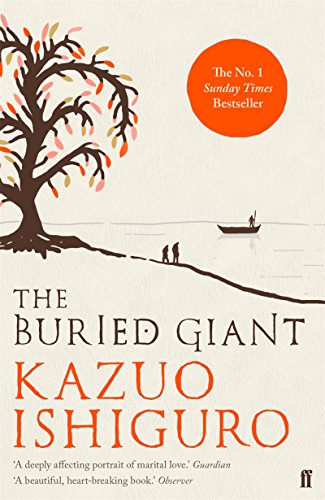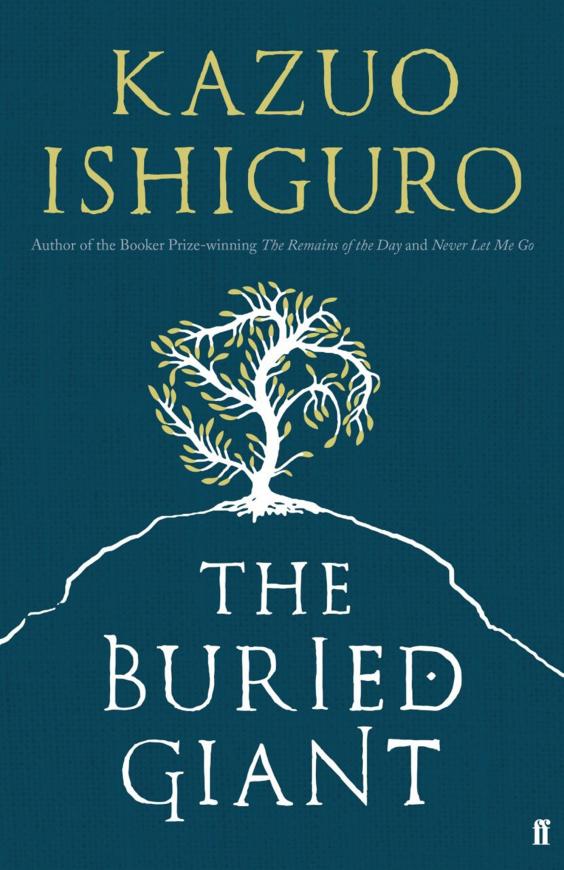 The Buried Giant (2015)
The Buried Giant (2015)
Written by: Kazuo Ishiguro
Genre: Fantasy/Literary Fantasy
Pages: 317
Publisher: Alfred A. Knopf
Why I Chose It: The last Ishiguro book I read was The Remains of The Day, which was sad and beautiful all at the same time and which I absolutely loved. I’ve been wanting to read The Buried Giant, but had too many things on my to-do list. Reviewing it seemed like a great opportunity to bump it up to the top of said list. Plus, that cover. It’s beautiful. Also, I adore Ishiguro’s storytelling; he’s a master of precise language. Also — no, I will stop there.
The premise:
In post-Arthurian Britain, the wars that once raged between the Saxons and the Britons have finally ceased. Axl and Beatrice, an elderly British couple, set off to visit their son, whom they haven’t seen in years. And, because a strange mist has caused mass amnesia throughout the land, they can scarcely remember anything about him.
As they are joined on their journey by a Saxon warrior, his orphan charge, and an illustrious knight, Axl and Beatrice slowly begin to remember the dark and troubled past they all share. By turns savage, suspenseful, and intensely moving, The Buried Giant is a luminous meditation on the act of forgetting and the power of memory, an extraordinary tale of love, vengeance, and war.
SPOILERS: I’ll do my best to talk about this book while avoiding spoilers. But yes, there are plot twists and you should read it. If you think this warning is ambiguous, that’s because the story is ambiguous.
 Discussion: Ishiguro, like Virginia Woolf in Mrs. Dalloway, does a lot with conversational silences. In Mrs. Dalloway, what is said by characters often is not what is felt or thought by them; the subconscious, aka the true self, can only be accessed by reading what is not said. Since the reader is the only one who can do this, the reader is the only one who is presented with overt evidence that those feelings don’t match up with dialogue or action. Similarly, because the characters in The Buried Giant are almost all suffering from a kind of mass amnesia, the dialogue between Ishiguro’s characters can be vague in meaning — giving the reader the uneasy feeling that there is much more beneath the surface, and leaving room for lots of questions (and therefore, lots of foreshadowing if you look in the right places).
Discussion: Ishiguro, like Virginia Woolf in Mrs. Dalloway, does a lot with conversational silences. In Mrs. Dalloway, what is said by characters often is not what is felt or thought by them; the subconscious, aka the true self, can only be accessed by reading what is not said. Since the reader is the only one who can do this, the reader is the only one who is presented with overt evidence that those feelings don’t match up with dialogue or action. Similarly, because the characters in The Buried Giant are almost all suffering from a kind of mass amnesia, the dialogue between Ishiguro’s characters can be vague in meaning — giving the reader the uneasy feeling that there is much more beneath the surface, and leaving room for lots of questions (and therefore, lots of foreshadowing if you look in the right places).
The Buried Giant explores some of the same themes of memory, impending death, and identity that Ishiguro has written about in previous books, but in a more fantastical setting. Ishiguro uses quiet, precise language to craft a dreamlike quest story set in a recently post-Arthurian Britain — a Britain populated by Saxons, Britons, common folk, warriors, pixies, ogres, and dragons. And I think this is interesting, because it fills a gap in the literature. Arthur is commonly thought of as a person from the Middle Ages, but evidence suggests he may have existed further back in time, when the Romans were occupying the British Isles. Either way, there are thousands of legends and stories about King Arthur, his court, and the battles he and his knights fought in order to unify Britain. Everything after that is a blank time — or if there are things written about post-Arthurian Britain, I haven’t encountered them yet. The Buried Giant is probably set in a post-Roman-Arthur Britain.
In the first few pages the reader is introduced to Axl and Beatrice, an elderly couple who lives in a kind of village-warren with other common folk. They are ostracized from the village, treated as strange and weird, but they don’t seem to notice, or mind it. Instead Axl and Beatrice are preoccupied with hazy, dim memories of a son they once had. Suddenly aware of the fragility of their memories, they decide to leave their community and travel to their son’s village before they forget him completely.
“I’m wondering if without our memories, there’s nothing for it but for our love to fade and die.”
 On their quest, they meet a warrior, Wistan, who has been sent on a mission by his king to kill the dragon, Querig, lest the dragon be recruited to the army of a menacing warrior-king. Wistan rescues a young boy named Edwin from a trio of ogres. Edwin was bitten during the encounter, so his village, believing he will turn into an ogre, tosses him out. Wistan takes him on as his apprentice, and they travel with Axl and Beatrice to a monastery.
On their quest, they meet a warrior, Wistan, who has been sent on a mission by his king to kill the dragon, Querig, lest the dragon be recruited to the army of a menacing warrior-king. Wistan rescues a young boy named Edwin from a trio of ogres. Edwin was bitten during the encounter, so his village, believing he will turn into an ogre, tosses him out. Wistan takes him on as his apprentice, and they travel with Axl and Beatrice to a monastery.
On the way, Axl, Beatrice and Wistan share their concerns about distant memories. For it isn’t just them who can’t remember even recent events, but almost everyone they meet — even their old villagers might not even remember they existed, and Axl and Beatrice have only been gone two days. Wistan is convinced he knows Axl.
Beatrice, already frail and elderly, lately has been troubled by a pain in her side, and has been told a monk named Father Jonus will know the cure for her troubles. Along the way, they meet an elderly Sir Gawain, who reveals that the mist is what makes everyone forget, and the mist is the breath of Querig. Gawain too, at Wistan’s prompting, also seems to know Axl.
Beatrice finds relief at the monastery, but Wistan and Edwin discover the monastery is really a repurposed hillfort, and that the monks are hiding a deadly secret. When the monks, tipped off by Sir Gawain, betray them to the warrior-king’s forces, Wistan fights them off. Axl, Edwin, and Beatrice escape — but not without encountering that deadly secret first! — and continue on their journey toward their son’s village. Eventually they are roped into helping Wistan slay the dragon Querig — with all of the attendant consequences.
To tell you more would be to spoil all of it. Let me just say that no one is who they say they are, nothing really is what it seems, and betrayals abound. The story is all at once a tour of fantastical England, presented as common fact (dragons, pixies, and ogres!); a comment on utopian Arthurian literature; a love story; and a comment on the act of forgetting history, both personal and communal. Can you be who you are if you don’t remember your past? Is a society doomed to repeat its mistakes?
“Who knows what will come when quick-tongued men make ancient grievances rhyme with fresh desire for land and conquest?”
 The story was difficult to get into. It doesn’t really pick up until about a hundred pages in, and by pick up, I mean imagine yourself floating on a lazy river whose current picks up a little bit of speed. But you are not heading toward any waterfalls, and if you go through any rapids, they will not be dangerous ones. Ishiguro seems to be recounting a tale of a quest that he heard thirdhand; I felt very removed from the action. In that way it’s exactly like reading a book of fairy tales.
The story was difficult to get into. It doesn’t really pick up until about a hundred pages in, and by pick up, I mean imagine yourself floating on a lazy river whose current picks up a little bit of speed. But you are not heading toward any waterfalls, and if you go through any rapids, they will not be dangerous ones. Ishiguro seems to be recounting a tale of a quest that he heard thirdhand; I felt very removed from the action. In that way it’s exactly like reading a book of fairy tales.
Ishiguro uses a mishmash of points of view, which adds to the languorous, dreamlike disjointedness of the narrative: the first part, which introduces Axl and Beatrice and the need for their quest, is framed in second person and moves between that and third-person omniscient. The second part is told from the point of view of Edwin, but uses third-person omniscient. The third, first-person and definitely not omniscient, tells the story from Sir Gawain’s limited, slightly crazed perspective; and the fourth returns to the second-person/third-person framing device, while introducing a new character. It’s true; Ishiguro breaks all the writing rules. But this is not a weakness of the book, however; I don’t think I want to read this quest story just from Axl and Beatrice’s point(s) of view. Rotating the points of view among the characters benefits the overall narrative.
The dialogue was hard to get used to, but it’s very polite and in that way it is also a callback to the fairy tales and legends of yore. There are plenty of “good sirs,” “friends, let us…” and duels and swordfights begin with a courteous “If we must, we must.” Characters are given to monologues (also like the old fairy tales), and sometimes those were difficult to wade through — even for those of us who grew up on tales of knights errant. But, as mentioned above, the dialogue raises plenty of questions for the reader, because contained within that precise language are hints about the characters, their past lives, and the reason for the mist that made everyone forget almost everything and everyone.
“The giant, once well buried, now stirs. When soon he rises, as surely he will, the friendly bonds between us will prove as knots young girls make with the stems of small flowers.”
In Conclusion: The ending is ambiguous, so beware, Dear Reader. The story will leave you with more questions than answers. (The reason for the existence of the mist is a real kicker, though.) Overall, The Buried Giant is a beautiful story and well worth the time for those of us who grew up on Arthurian legends, but you will need to know some of the basics of those legends to understand most of the references, especially toward the end. If you’re looking for a quest story with a lot of action, and don’t know much about Arthurian lore, this will come across as odd as a rewatch of Conan the Barbarian. That said, the story’s oddity is also its beauty, and its themes are always timely.

Sounds complex and interesting. I’m going to add it to my “get from the library” list.
Interesting. Now I want to read ALL the spoilers!